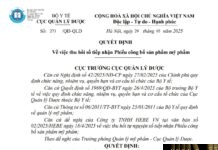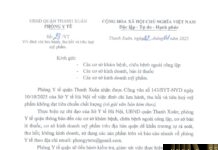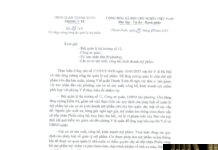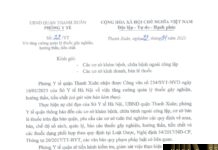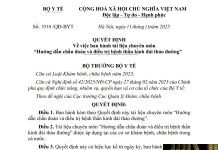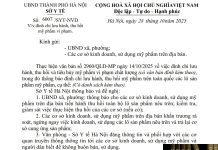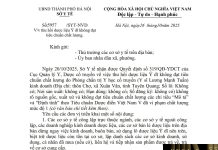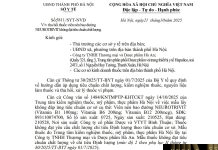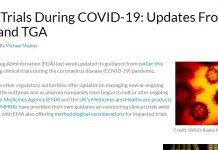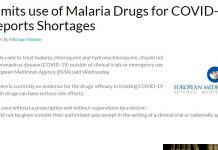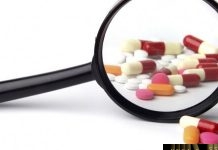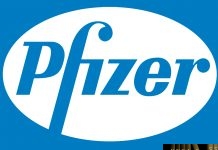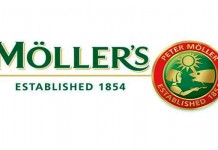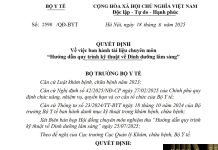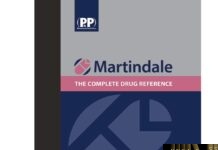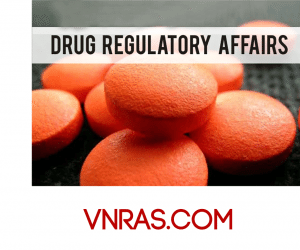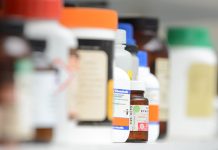ASEAN Cosmetic Documents Appendix VI – ASEAN Guideline for Cosmetic Good Manufacturing Practice
Appendix VI
ASEAN Guidelines for Cosmetic Good Manufacturing Practice
PREAMBLE
The GMP Guidelines have been produced to offer assistance to the cosmetic industry in compliance with the provisions of the ASEAN Cosmetic Directive. As this document is particularly intended for cosmetic products, clear delineation from drug or pharmaceutical product GMP should be kept in mind.
The Good Manufacturing Practices presented here is only a general guideline for the manufacturers to develop its own internal quality management system and procedures. The important objective must be met in any case, i.e. the final products must meet the quality standards appropriate to their intended use to assure consumer’s health and benefit.
1. INTRODUCTION
The objective of the Cosmetic Good Manufacturing Practice (GMP) guidelines is to ensure that products are consistently manufactured and controlled to the specified quality. It is concerned with all aspects of production and quality control.
1.1 General Consideration
1.1.1 In the manufacture of cosmetic products, overall control and monitoring is essential to ensure that the consumer receives products of specified quality.
1.1.2 The quality of a product depends on the starting materials, production and quality control processes, building, equipment and personnel involved.
1.2 Quality Management System
1.2.1 A quality system should be developed, established and implemented as a means by which stated policies and objectives will be achieved. It should define the organisational structure, functions, responsibilities, procedures, instructions, processes and resources for implementing the quality management.
1.2.2 The quality system should be structured and adapted to the company’s activities and to the nature of its products and should take into consideration appropriate elements stated in this Guidelines.
1.2.3 The quality system operation should ensure that if necessary, samples of starting materials, intermediate, and finished products are taken, tested to determine their release or rejection on the basis of test results and other available evidence related to quality.
2. PERSONNEL
There should be an adequate number of personnel having knowledge, experience, skill and capabilities relevant to their assigned function. They should be in good health and capable of handling the duties assigned to them.
2.1 Organisation, Qualification and Responsibilities
2.1.1 The organisational structure of the company shall be such that the production and the quality control sections are headed by different persons, neither of whom shall be responsible to the other.
2.1.2 The head of production should be adequately trained and experienced in cosmetic manufacturing.
He should have authority and responsibilities to manage production of products covering operations, equipment, production personnel, production areas and records.
2.1.3 The head of quality control should be adequately trained and experienced in the field of quality control. He should be given full authority and responsibility in all quality control duties such as establishment, verification and implementation of all quality control procedures. He should have the authority to designate/assign when appropriate, personnel, to approve starting materials, intermediates, bulk and finished products that meet the specification or to reject those which do not conform to the relevant specification or which were not manufactured in accordance with approved procedures and under the defined conditions.
2.1.4 The responsibilities and authority of key personnel should be clearly defined.
2.1.5 An adequate number of trained personnel should be appointed to execute direct supervision in each section of the production and the quality control unit.
2.2 Training
2.2.1 All personnel directly involved in the manufacturing activities should be appropriately trained in manufacturing operations in accordance to GMP principles. Special attention should be given to training of personnel working with any hazardous materials
2.2.2 Training in GMP should be conducted on a continuous basis.
2.2.3 Records of training should be maintained and its effectiveness assessed periodically.
3. PREMISES
The premises for manufacturing should be suitably located, designed, constructed and maintained.
3.1 Effective measures should be taken to avoid any contamination from the surrounding environment and from pests.
3.2 Household products containing non-hazardous materials/ingredients and cosmetic products can share the same premises and equipment provided that due care should be exercised to prevent cross contamination and risk of mix-up.
3.3 Painted line, plastic curtain and flexible barrier in the form of rope or tape may be employed to prevent mix-up.
3.4 Appropriate changing rooms and facilities should be provided. Toilets should be separated from the production areas to prevent product contamination/cross contamination.
3.5 Defined areas should be provided for, wherever possible and applicable:
3.5.1 Materials receiving.
3.5.2 Material Sampling
3.5.3 Incoming goods and quarantine.
3.5.4 Starting materials storage.
3.5.5 Weighing and dispensing.
3.5.6 Processing.
3.5.7 Storage of bulk products.
3.5.8 Packaging.
3.5.9 Quarantine storage before final release of products.
3.5.10 Storage of finished products.
3.5.11 Loading and unloading.
3.5.12 Laboratories.
3.5.13 Equipment washing.
3.6 Wall and ceiling, where applicable should be smooth and easy to maintain. The floor in processing areas should have a surface that is easy to clean and sanitise.
3.7 Drains should be of adequate size and should have trapped gullies and proper flow. Open channels should be avoided where possible, but if required they should be able to facilitate cleaning and disinfection.
3.8 Air intakes and exhausts and associated pipework and ducting, when applicable, should be installed in such a way as to avoid product contamination.
3.9 Buildings should be adequately lit and properly ventilated appropriate to the operations.
3.10 Pipework, light fittings, ventilation points and other services in manufacturing areas should preferably be installed in such a way as to avoid uncleanable recesses and run outside the processing areas.
3.11 Laboratories should preferably be physically separated from the production areas.
3.12 Storage areas should be of adequate space provided with suitable lighting, arranged and equipped to allow dry, clean and orderly placement of stored materials and products.
3.12.1 Such areas should be suitable for effective separation of quarantined materials and products. Special and segregated areas should be available for storage of flammable and explosive substances, highly toxic substances, rejected and recalled materials or returned goods.
3.12.2 Where special storage conditions e.g. temperature, humidity and security are required, these should be provided.
3.12.3 Storage arrangements should permit separation of different labels and other printed materials to avoid mix-up.
4. EQUIPMENT
Equipment should be designed and located to suit the production of the product.
4.1 Design and Construction
4.1.1 The equipment surfaces coming into contact with any in-process material should not react with or adsorb the materials being processed.
4.1.2 Equipment should not adversely affect the product through leaking valves, lubricant drips and through inappropriate modifications or adaptations.
4.1.3 Equipment should be easily cleaned.
4.1.4 Equipment used for flammable substances should be explosion proof.
4.2 Installation and Location
4.2.1 Equipment should be located to avoid congestion and should be properly identified to assure that products do not become admixed or confused with one another.
4.2.2 Water, steam and pressure or vacuum lines, where applicable, should be installed so as to be easily accessible during all phases of operation. They should be clearly identified.
4.2.3 Support systems such as heating, ventilation, air conditioning, water (such as potable, purified, distilled), steam, compressed air and gases (example nitrogen) should function as designed and identifiable.
4.3 Maintenance
Weighing, measuring, testing and recording equipment should be serviced and calibrated regularly. All records should be maintained.
5. SANITATION AND HYGIENE
Sanitation and hygiene should be practised to avoid contamination of the manufacturing of products. It should cover personnel, premises, equipment/apparatus and production materials and containers.
5.1 Personnel
5.1.1 Personnel should be healthy to perform their assigned duties. Regular medical examination must be conducted for all production personnel involved with manufacturing processes.
5.1.2 Personnel must practise good personal hygiene..
5.1.3 Any personnel shown at any time to have an apparent illness or open lesions that may adversely affect the quality of products should not be allowed to handle raw materials, packaging materials, in-process materials, and finished products.
5.1.4 Personnel should be instructed and encouraged to report to their immediate supervisor any conditions (plant, equipment or personnel) that they consider may adversely affect the products.
5.1.5 Direct physical contact with the product should be avoided to ensure protection of the product from contamination. Personnel should wear protective and clean attire appropriate to the duties they perform,.
5.1.6 Smoking, eating, drinking and chewing, , food, drinks and smoking materials and other materials that might contaminate are not permitted in production, laboratory, storage or other areas where they might adversely affect product quality.
5.1.7 All authorised personnel entering the production areas should practice personal hygiene including proper attire.
5.2 Premises
5.2.1 Adequate employee’s washing and well ventilated toilet facilities should be provided and separated from the production area.
5.2.2 Suitable locker facilities should be provided at appropriate location for the storage of employees’ clothing and personal belongings.
5.2.3 Waste material should be regularly collected in suitable receptacles for removal to collection points outside the production area.
5.2.4 Rodenticides, insecticides, fumigating agents and sanitising materials must not contaminate equipment, raw materials, packaging materials, in-process materials or finished products.
5.3 Equipment and Apparatus
5.3.1 Equipment and utensils should be kept clean.
5.3.2 Vacuum or wet cleaning methods are preferred. Compressed air and brushes should be used with care and avoided if possible, as they increase the risk of product contamination.
5.3.3 Standard operating procedures must be followed for cleaning and sanitising of major machines.
6. PRODUCTION
6.1 Starting Materials
6.1.1 Water
Special attention should be paid to water, since it is an important raw material. Water production equipment and water systems should supply quality water. Water systems should be sanitized according to well-established procedures.
The chemical and microbiological quality of water used in production should be monitored regularly, according to written procedures and any anomaly should be followed by corrective action.
The choice of method for water treatment such as deionisation, distillation or filtration depends on product requirement. The storage as well as delivery system should be properly maintained.
6.1.2 Verification of materials
All deliveries of raw materials and packaging materials should be checked and verified for their conformity to specifications and be traceable to the product.
Samples of raw materials should be physically checked for conformity to specifications prior to release for use. The raw materials should be clearly labelled. All goods must be clean and checked for appropriate protective packing to ensure no leakage, perforation or exposure.
6.1.3 Rejected materials
Deliveries of raw materials that do not comply with specification should be segregated and disposed according to standard operating procedures.
6.2 Batch Numbering System
6.2.1 Every finished product should bear a production identification number which enables the history of the product to be traced..
6.2.2 A batch numbering system should be specific for the product and a particular batch number should not be repeated for the same product in order to avoid confusion.
6.2.3 Whenever possible, the batch number should be printed on the immediate and outer container of the product.
6.2.4 Records of batch number should be maintained.
6.3 Weighing and Measurement
6.3.1 Weighing should be carried out in the defined areas using calibrated equipment.
6.3.2 All weighing and measurement carried out should be recorded and , where applicable, counterchecked.
6.4 Procedure and Processing
6.4.1 All starting materials used should be approved according to specifications.
6.4.2 All manufacturing procedures should be carried out according
to written procedures 6.4.3 All required in-process controls should be carried out and recorded.
6.4.4 Bulk products should be properly labelled until approved by Quality Control, where applicable.
6.4.5 Particular attention should be paid to problem of cross-contamination in all stages of processing.
6.5 Dry Products
Handling of dry materials and products should be given special attention. Where possible, dust-containing production system, central vacuum system or other suitable methods should be employed.
6.6 Wet Products
6.6.1 Liquids, creams and lotions should be produced in such a way as to protect the product from microbial and other contamination.
6.6.2 The use of closed systems of production and transfer is recommended.
6.6.3 Where pipe-lines are used for delivery of ingredients or bulk products, care should be taken to ensure that the systems are easy to clean.
6.7 Labelling and Packaging
6.7.1 Packaging line should be inspected for clearance prior to operation. Equipment should be clean and functional. All materials and products from previous packaging operation should have been removed.
6.7.2 Samples should be taken and checked at random during labelling and packaging operations.
6.7.3 Each labelling and packaging line should be clearly identified to avoid mix-up.
6.7.4 Excess labels and packaging materials should be returned to store and recorded. Any rejected packaging materials should be disposed off accordingly..
6.8 Finished Product: Quarantine and Delivery to Finished Stock
6.8.1 All finished products should be approved by Quality Control prior to release.
7. QUALITY CONTROL
7.1 Introduction
Quality control is an essential part of GMP. It provides assurance that cosmetic products will be of consistent quality appropriate to their intended use.
7.1.1 A quality control system should be established to ensure that products contain the correct materials of specified quality and quantity and are manufactured under proper conditions according to standard operating procedures.
7.1.2 Quality control involves sampling, inspecting and testing of starting materials, in process, intermediate, bulk, and finished products. It also includes where applicable, environmental monitoring programs, review of batch documentation, sample retention program, stability studies and maintaining correct specifications of materials and products.
7.2 Reprocessing
7.2.1 The methods of reprocessing should be evaluated to ensure that they do not affect the quality of the product.
7.2.2 Additional testing of any finished product which has been reprocessed should be performed.
7.3 Returned Products
7.3.1 Returned products should be identified and stored separately either in allocated area or by moveable barrier such as rope or tape.
7.3.2 All returned products should be tested if necessary, in addition to physical evaluation before being released for distribution.
7.3.3 Returned products which do not comply with the original specification should be rejected.
7.3.4 Rejected products should be disposed according to appropriate procedures.
7.3.5 Records of returned products must be maintained.
8. DOCUMENTATION
8.1 Introduction
The documentation system should include the complete history of each batch, from starting materials to finished products. The system should record executed activities for maintenance, storage, quality control, primary distribution and other specific matters related to GMP.
8.1.1 There should be a system for preventing the use of any superseded document.
8.1.2 If an error is made or detected on a document, it should be corrected in such a manner that the original entry is not lost and correction is made close to the original entry, initialled and dated.
8.1.3 Where documents bear instructions they should be clearly written step by step.
8.1.4 Documents should be dated and authorised.
8.1.5 Documents should be readily available to relevant parties.
8.2 Specifications
All specifications should be approved by authorised personnel.
8.2.1 Raw and packaging material specifications should include :
(a) Name of material
(b) Description of the material
(c) Testing parameters and acceptance limits
(d) Technical drawings, where applicable.
(e) Special precautions e.g. storage and safety conditions, if necessary.
8.2.2 Bulk and finished product specifications should include :
(a) Name of product
(b) Description
(c) Physical properties
(d) Chemical assay and/or microbiological assays and their acceptance limits ; if necessary
(e) Storage conditions and safety precautions, if necessary
8.3 Documents for Production
8.3.1 Master Formula
The Master formula should be available upon request. This document should contain the following information:
(a) Product name and product code/number.
(b) Intended packaging materials, and storage conditions
(c) List of raw materials used
(d) List of equipment used.
(e) In-process controls with their limits in processing and packaging, where applicable.
8.3.2 Batch Manufacturing Record ( BMR )
(a) Batch Manufacturing Records should be prepared for each batch of product.
(b) Each BMR should include the following :
i. Name of product
ii. Batch formula
iii. Brief manufacturing process
iv. Batch or code number
v. Date of the start and finish of processing and packaging
vi. Identity of individual major equipment and lines or location used
vii. Records of cleaning of equipment used for processing as appropriate
viii. In-process control and laboratory results, such as pH and temperature test records
ix. Packaging line clearance inspection records
x. Any sampling performed during various steps of processing
xi. Any investigation of specific failure or discrepancies
xii. Results of examinations on packed and labelled products
8.3.3 Records for Quality Control
(a) Records for each testing, assay result and release or rejection of starting materials, intermediates, bulk and finished product should be maintained.
(b) These records may include :
i. Date of test
ii. Identification of the material
iii. Supplier name
iv. Date of receipt
v. Original batch number if any
vi. Batch number
vii. Quality control number
viii. Quantity received
ix. Date of sampling
x. Quality control results
9. INTERNAL AUDITS
An internal audit consists of an examination and assessment of all or part of a quality system with the specific purpose of improving it. An internal audit may be conducted by outside or independent specialists or a team designated by the management for this purpose. Such internal audits may also be extended to suppliers and contractors, if necessary. A report should be made at the completion of each internal audit.
10. STORAGE
10.1 Storage Areas
10.1.1 Storage areas should be of sufficient capacity to allow orderly storage of the various categories of materials and products such as starting and packaging materials, intermediates, bulk and finished products, products in quarantine, and released, rejected, returned, or recalled products.
10.1.2 Storage areas should be designed or adapted to ensure good storage conditions. They should be clean, dry and well-maintained. Where special storage conditions are required (temperature and humidity) these should be provided, checked and monitored.
10.1.3 Receiving and dispatch bays should protect materials and products from weather. Reception areas should be designed and equipped to allow incoming materials to be cleaned if necessary before storage.
10.1.4 Storage areas for quarantine products should be clearly demarcated.
10.1.5 Wherever possible sampling area for starting materials should be provided to prevent contamination.
10.1.6 Hazardous materials should be safely and securely stored.
10.2 Stock Handling and Control
10.2.1 Receiving Products
10.2.1.1 Upon receipt, each incoming delivery should be checked against the relevant documentation and physically verified by label description, type and quantity.
10.2.1.2 The consignment should be carefully inspected for defects and damage. Records should be retained for each delivery.
10.2.2 Control
10.2.2.1 Records should be maintained showing all receipts and issues of products.
10.2.2.2 Issues should observe the principle of stock rotation (first in – first out).
10.2.2.3 All labels and containers of products should not be altered, tampered or changed.
11. CONTRACT MANUFACTURING AND ANALYSIS
The conditions of contract manufacturing and analysis should be clearly defined, agreed, and controlled so as to avoid misunderstandings, which could result in a product or work of unsatisfactory quality. All aspects of contracted work should be specified to obtain a quality product conforming to the agreed standards.
There should be a written contract between the principal and the contract manufacturer to clearly establish the duties and responsibilities of each party.
12. COMPLAINTS
12.1 A person responsible for handling complaints and deciding the measures to be taken should be designated. If this person is different from the authorised person, the latter should be made aware of any complaint, investigation or recall.
12.2 There should be written procedures describing the action to be taken, including the need to consider a recall, in the case of a complaint involving a possible product defect.
12.3 Complaints involving product defects should be recorded with all the original details and investigated.
12.4 If a product defect is discovered or suspected in a batch, consideration should be given to whether other batches should be checked in order to determine whether they are also affected. In particular, other batches that may contain reprocessed product from the defective batch should be investigated.
12.5 Where necessary, appropriate follow-up action, possibly including product recall, should be taken after investigation and evaluation of the complaint.
12.6 All the decisions and measures taken as a result of a complaint should be recorded and referenced to the corresponding batch records.
12.7 Complaint records should be regularly reviewed for an indication of specific or recurring problems that require attention and might justify the recall of marketed products.
12.8 The competent authority should be informed if a manufacturer is considering action following possibly faulty manufacture and product deterioration, which may lead to serious safety issues.
13. PRODUCT RECALLS
There should be a system of recall from the market of products known or suspected to be defective.
13.1 A person responsible for the execution and co-ordination of recalls should be designated, as well as sufficient personnel, to handle all aspects of recalls with the appropriate degree of urgency.
13.2 Written procedures for recall should be established and regularly reviewed. Recall operations should be capable of being initiated promptly.
13.3 The primary distribution records should be readily available to the person(s) responsible for recalls, and they should contain sufficient information of distributors.
13.4 The progress of the recall process should be recorded and a final report issued, including a reconciliation between the delivered and recovered quantities of the products.
13.5 The effectiveness of the arrangements for recalls should be evaluated from time to time.
13.6 A written instruction should be established to ensure recalled products are stored securely in a segregated area while awaiting decision..
14. GLOSSARY
14.1 Batch
A quantity of any cosmetic product produced in a given cycle of manufacture that is uniform in character and quality.
14.2 Batch Number
A designation in numbers and/or letters or combination of both that identifies the complete history of the batch, quality control and distribution.
14.3 Bulk Product
Any processed product which will have to undergo the packaging operation in order to become a finished product.
14.4 Calibration
Combination of checking an instrument and adjusting it to bring it within its limits for accuracy according to recognized standards.
14.5 Date of Manufacture
Date of manufacturing of a batch of product.
14.6 Documentation
All written procedures, instructions and records involved in the manufacture and quality control of products.
14.7 Product
Any substance or preparation intended to be used, or capable or purported or claimed to be capable of being used, in or for cleansing, improving, altering or beautifying the complexion, skin, hair or teeth.
14.8 Finished Product
A product which has undergone all stages of manufacturing operations.
14.9 In-Process Control
Checks and tests instituted and carried out in the course of the manufacture of a product including checks and tests done on environment and equipment in order to ensure that the end product will comply with its specification.
14.10 Intermediate Product
Any processed substance or mixture of substances which has to undergo one or more stages of processing to become a bulk product.
14.11 Manufacture or Manufacturing
The complete set of activities to produce a product, comprising of production and quality control, from acquisition of all raw materials through processing and subsequent packaging and release for distribution of the finished product.
14.12 Packaging
The part of production cycle applied to a bulk product to obtain the finished product.
14.13 Packaging Material
Any material used in the packaging of a bulk product to obtain the finished product.
14.14 Processing
The part of production cycle starting from weighing of raw materials to obtaining a bulk product.
14.15 Production
All operations starting from processing to packaging to obtain a finished product.
14.16 Quality Control
All measures taken during manufacturing which are designed to ensure the uniform output of product that will conform to established specifications.
14.17 Quarantine
The status of materials or products set apart physically or by system, while awaiting a decision for their rejection or release for processing, packaging or distribution.
14.18 Raw Materials
Any ingredient to be used in the formulation of a cosmetic product.
14.19 Rejected
The status of materials or products which are not permitted to be used for processing, packaging or distribution.
14.20 Released
The status of materials or products which are allowed to be used for processing, packaging or distribution.
14.21 Returned Product
Finished products sent back to the manufacturer.
14.22 Sanitation
Hygienic control on manufacturing premises, personnel, equipment and material handling.
14.23 Specification of Materials
A description of a starting material or finished product in terms of its chemical, physical and biological characteristics, if applicable. A specification normally includes descriptive and numerical clauses stating standards and tolerated deviations.
14.24 Starting Materials
Raw materials and packaging materials used in the production of products.
15. REFERENCES
15.1 Good Manufacturing Practices for Pharmaceutical Products, World Health Organisation ( WHO ) Technical Report Series No : 823, 1992
15.2 Good Storage Practice, 1st Edition, January 1995, ISBN 983-9870-14-9, National Pharmaceutical Control Bureau, Malaysia
15.3 Cosmetic Good Manufacturing Practices, COLIPA – The European Cosmetic Toiletry and Perfumery Association, July 1994
15.4 Australian Code of Good Manufacturing Practice for Therapeutic Goods – Sunscreen Products, Therapeutic Goods Administration ( TGA ), Australia, February 1994
15.5 Guidelines on Good Manufacturing Practice ( GMP ) for Traditional Medicines, National Pharmaceutical Control Bureau, Malaysia, 1st Edition, 1999ASEAN Cosmetic Documents Appendix VI – ASEAN Guideline for Cosmetic Good Manufacturing Practice
Appendix VI
ASEAN Guidelines for Cosmetic Good Manufacturing Practice
PREAMBLE
The GMP Guidelines have been produced to offer assistance to the cosmetic industry in compliance with the provisions of the ASEAN Cosmetic Directive. As this document is particularly intended for cosmetic products, clear delineation from drug or pharmaceutical product GMP should be kept in mind.
The Good Manufacturing Practices presented here is only a general guideline for the manufacturers to develop its own internal quality management system and procedures. The important objective must be met in any case, i.e. the final products must meet the quality standards appropriate to their intended use to assure consumer’s health and benefit.
1. INTRODUCTION
The objective of the Cosmetic Good Manufacturing Practice (GMP) guidelines is to ensure that products are consistently manufactured and controlled to the specified quality. It is concerned with all aspects of production and quality control.
1.1 General Consideration
1.1.1 In the manufacture of cosmetic products, overall control and monitoring is essential to ensure that the consumer receives products of specified quality.
1.1.2 The quality of a product depends on the starting materials, production and quality control processes, building, equipment and personnel involved.
1.2 Quality Management System
1.2.1 A quality system should be developed, established and implemented as a means by which stated policies and objectives will be achieved. It should define the organisational structure, functions, responsibilities, procedures, instructions, processes and resources for implementing the quality management.
1.2.2 The quality system should be structured and adapted to the company’s activities and to the nature of its products and should take into consideration appropriate elements stated in this Guidelines.
1.2.3 The quality system operation should ensure that if necessary, samples of starting materials, intermediate, and finished products are taken, tested to determine their release or rejection on the basis of test results and other available evidence related to quality.
2. PERSONNEL
There should be an adequate number of personnel having knowledge, experience, skill and capabilities relevant to their assigned function. They should be in good health and capable of handling the duties assigned to them.
2.1 Organisation, Qualification and Responsibilities
2.1.1 The organisational structure of the company shall be such that the production and the quality control sections are headed by different persons, neither of whom shall be responsible to the other.
2.1.2 The head of production should be adequately trained and experienced in cosmetic manufacturing.
He should have authority and responsibilities to manage production of products covering operations, equipment, production personnel, production areas and records.
2.1.3 The head of quality control should be adequately trained and experienced in the field of quality control. He should be given full authority and responsibility in all quality control duties such as establishment, verification and implementation of all quality control procedures. He should have the authority to designate/assign when appropriate, personnel, to approve starting materials, intermediates, bulk and finished products that meet the specification or to reject those which do not conform to the relevant specification or which were not manufactured in accordance with approved procedures and under the defined conditions.
2.1.4 The responsibilities and authority of key personnel should be clearly defined.
2.1.5 An adequate number of trained personnel should be appointed to execute direct supervision in each section of the production and the quality control unit.
2.2 Training
2.2.1 All personnel directly involved in the manufacturing activities should be appropriately trained in manufacturing operations in accordance to GMP principles. Special attention should be given to training of personnel working with any hazardous materials
2.2.2 Training in GMP should be conducted on a continuous basis.
2.2.3 Records of training should be maintained and its effectiveness assessed periodically.
3. PREMISES
The premises for manufacturing should be suitably located, designed, constructed and maintained.
3.1 Effective measures should be taken to avoid any contamination from the surrounding environment and from pests.
3.2 Household products containing non-hazardous materials/ingredients and cosmetic products can share the same premises and equipment provided that due care should be exercised to prevent cross contamination and risk of mix-up.
3.3 Painted line, plastic curtain and flexible barrier in the form of rope or tape may be employed to prevent mix-up.
3.4 Appropriate changing rooms and facilities should be provided. Toilets should be separated from the production areas to prevent product contamination/cross contamination.
3.5 Defined areas should be provided for, wherever possible and applicable:
3.5.1 Materials receiving.
3.5.2 Material Sampling
3.5.3 Incoming goods and quarantine.
3.5.4 Starting materials storage.
3.5.5 Weighing and dispensing.
3.5.6 Processing.
3.5.7 Storage of bulk products.
3.5.8 Packaging.
3.5.9 Quarantine storage before final release of products.
3.5.10 Storage of finished products.
3.5.11 Loading and unloading.
3.5.12 Laboratories.
3.5.13 Equipment washing.
3.6 Wall and ceiling, where applicable should be smooth and easy to maintain. The floor in processing areas should have a surface that is easy to clean and sanitise.
3.7 Drains should be of adequate size and should have trapped gullies and proper flow. Open channels should be avoided where possible, but if required they should be able to facilitate cleaning and disinfection.
3.8 Air intakes and exhausts and associated pipework and ducting, when applicable, should be installed in such a way as to avoid product contamination.
3.9 Buildings should be adequately lit and properly ventilated appropriate to the operations.
3.10 Pipework, light fittings, ventilation points and other services in manufacturing areas should preferably be installed in such a way as to avoid uncleanable recesses and run outside the processing areas.
3.11 Laboratories should preferably be physically separated from the production areas.
3.12 Storage areas should be of adequate space provided with suitable lighting, arranged and equipped to allow dry, clean and orderly placement of stored materials and products.
3.12.1 Such areas should be suitable for effective separation of quarantined materials and products. Special and segregated areas should be available for storage of flammable and explosive substances, highly toxic substances, rejected and recalled materials or returned goods.
3.12.2 Where special storage conditions e.g. temperature, humidity and security are required, these should be provided.
3.12.3 Storage arrangements should permit separation of different labels and other printed materials to avoid mix-up.
4. EQUIPMENT
Equipment should be designed and located to suit the production of the product.
4.1 Design and Construction
4.1.1 The equipment surfaces coming into contact with any in-process material should not react with or adsorb the materials being processed.
4.1.2 Equipment should not adversely affect the product through leaking valves, lubricant drips and through inappropriate modifications or adaptations.
4.1.3 Equipment should be easily cleaned.
4.1.4 Equipment used for flammable substances should be explosion proof.
4.2 Installation and Location
4.2.1 Equipment should be located to avoid congestion and should be properly identified to assure that products do not become admixed or confused with one another.
4.2.2 Water, steam and pressure or vacuum lines, where applicable, should be installed so as to be easily accessible during all phases of operation. They should be clearly identified.
4.2.3 Support systems such as heating, ventilation, air conditioning, water (such as potable, purified, distilled), steam, compressed air and gases (example nitrogen) should function as designed and identifiable.
4.3 Maintenance
Weighing, measuring, testing and recording equipment should be serviced and calibrated regularly. All records should be maintained.
5. SANITATION AND HYGIENE
Sanitation and hygiene should be practised to avoid contamination of the manufacturing of products. It should cover personnel, premises, equipment/apparatus and production materials and containers.
5.1 Personnel
5.1.1 Personnel should be healthy to perform their assigned duties. Regular medical examination must be conducted for all production personnel involved with manufacturing processes.
5.1.2 Personnel must practise good personal hygiene..
5.1.3 Any personnel shown at any time to have an apparent illness or open lesions that may adversely affect the quality of products should not be allowed to handle raw materials, packaging materials, in-process materials, and finished products.
5.1.4 Personnel should be instructed and encouraged to report to their immediate supervisor any conditions (plant, equipment or personnel) that they consider may adversely affect the products.
5.1.5 Direct physical contact with the product should be avoided to ensure protection of the product from contamination. Personnel should wear protective and clean attire appropriate to the duties they perform,.
5.1.6 Smoking, eating, drinking and chewing, , food, drinks and smoking materials and other materials that might contaminate are not permitted in production, laboratory, storage or other areas where they might adversely affect product quality.
5.1.7 All authorised personnel entering the production areas should practice personal hygiene including proper attire.
5.2 Premises
5.2.1 Adequate employee’s washing and well ventilated toilet facilities should be provided and separated from the production area.
5.2.2 Suitable locker facilities should be provided at appropriate location for the storage of employees’ clothing and personal belongings.
5.2.3 Waste material should be regularly collected in suitable receptacles for removal to collection points outside the production area.
5.2.4 Rodenticides, insecticides, fumigating agents and sanitising materials must not contaminate equipment, raw materials, packaging materials, in-process materials or finished products.
5.3 Equipment and Apparatus
5.3.1 Equipment and utensils should be kept clean.
5.3.2 Vacuum or wet cleaning methods are preferred. Compressed air and brushes should be used with care and avoided if possible, as they increase the risk of product contamination.
5.3.3 Standard operating procedures must be followed for cleaning and sanitising of major machines.
6. PRODUCTION
6.1 Starting Materials
6.1.1 Water
Special attention should be paid to water, since it is an important raw material. Water production equipment and water systems should supply quality water. Water systems should be sanitized according to well-established procedures.
The chemical and microbiological quality of water used in production should be monitored regularly, according to written procedures and any anomaly should be followed by corrective action.
The choice of method for water treatment such as deionisation, distillation or filtration depends on product requirement. The storage as well as delivery system should be properly maintained.
6.1.2 Verification of materials
All deliveries of raw materials and packaging materials should be checked and verified for their conformity to specifications and be traceable to the product.
Samples of raw materials should be physically checked for conformity to specifications prior to release for use. The raw materials should be clearly labelled. All goods must be clean and checked for appropriate protective packing to ensure no leakage, perforation or exposure.
6.1.3 Rejected materials
Deliveries of raw materials that do not comply with specification should be segregated and disposed according to standard operating procedures.
6.2 Batch Numbering System
6.2.1 Every finished product should bear a production identification number which enables the history of the product to be traced..
6.2.2 A batch numbering system should be specific for the product and a particular batch number should not be repeated for the same product in order to avoid confusion.
6.2.3 Whenever possible, the batch number should be printed on the immediate and outer container of the product.
6.2.4 Records of batch number should be maintained.
6.3 Weighing and Measurement
6.3.1 Weighing should be carried out in the defined areas using calibrated equipment.
6.3.2 All weighing and measurement carried out should be recorded and , where applicable, counterchecked.
6.4 Procedure and Processing
6.4.1 All starting materials used should be approved according to specifications.
6.4.2 All manufacturing procedures should be carried out according
to written procedures 6.4.3 All required in-process controls should be carried out and recorded.
6.4.4 Bulk products should be properly labelled until approved by Quality Control, where applicable.
6.4.5 Particular attention should be paid to problem of cross-contamination in all stages of processing.
6.5 Dry Products
Handling of dry materials and products should be given special attention. Where possible, dust-containing production system, central vacuum system or other suitable methods should be employed.
6.6 Wet Products
6.6.1 Liquids, creams and lotions should be produced in such a way as to protect the product from microbial and other contamination.
6.6.2 The use of closed systems of production and transfer is recommended.
6.6.3 Where pipe-lines are used for delivery of ingredients or bulk products, care should be taken to ensure that the systems are easy to clean.
6.7 Labelling and Packaging
6.7.1 Packaging line should be inspected for clearance prior to operation. Equipment should be clean and functional. All materials and products from previous packaging operation should have been removed.
6.7.2 Samples should be taken and checked at random during labelling and packaging operations.
6.7.3 Each labelling and packaging line should be clearly identified to avoid mix-up.
6.7.4 Excess labels and packaging materials should be returned to store and recorded. Any rejected packaging materials should be disposed off accordingly..
6.8 Finished Product: Quarantine and Delivery to Finished Stock
6.8.1 All finished products should be approved by Quality Control prior to release.
7. QUALITY CONTROL
7.1 Introduction
Quality control is an essential part of GMP. It provides assurance that cosmetic products will be of consistent quality appropriate to their intended use.
7.1.1 A quality control system should be established to ensure that products contain the correct materials of specified quality and quantity and are manufactured under proper conditions according to standard operating procedures.
7.1.2 Quality control involves sampling, inspecting and testing of starting materials, in process, intermediate, bulk, and finished products. It also includes where applicable, environmental monitoring programs, review of batch documentation, sample retention program, stability studies and maintaining correct specifications of materials and products.
7.2 Reprocessing
7.2.1 The methods of reprocessing should be evaluated to ensure that they do not affect the quality of the product.
7.2.2 Additional testing of any finished product which has been reprocessed should be performed.
7.3 Returned Products
7.3.1 Returned products should be identified and stored separately either in allocated area or by moveable barrier such as rope or tape.
7.3.2 All returned products should be tested if necessary, in addition to physical evaluation before being released for distribution.
7.3.3 Returned products which do not comply with the original specification should be rejected.
7.3.4 Rejected products should be disposed according to appropriate procedures.
7.3.5 Records of returned products must be maintained.
8. DOCUMENTATION
8.1 Introduction
The documentation system should include the complete history of each batch, from starting materials to finished products. The system should record executed activities for maintenance, storage, quality control, primary distribution and other specific matters related to GMP.
8.1.1 There should be a system for preventing the use of any superseded document.
8.1.2 If an error is made or detected on a document, it should be corrected in such a manner that the original entry is not lost and correction is made close to the original entry, initialled and dated.
8.1.3 Where documents bear instructions they should be clearly written step by step.
8.1.4 Documents should be dated and authorised.
8.1.5 Documents should be readily available to relevant parties.
8.2 Specifications
All specifications should be approved by authorised personnel.
8.2.1 Raw and packaging material specifications should include :
(a) Name of material
(b) Description of the material
(c) Testing parameters and acceptance limits
(d) Technical drawings, where applicable.
(e) Special precautions e.g. storage and safety conditions, if necessary.
8.2.2 Bulk and finished product specifications should include :
(a) Name of product
(b) Description
(c) Physical properties
(d) Chemical assay and/or microbiological assays and their acceptance limits ; if necessary
(e) Storage conditions and safety precautions, if necessary
8.3 Documents for Production
8.3.1 Master Formula
The Master formula should be available upon request. This document should contain the following information:
(a) Product name and product code/number.
(b) Intended packaging materials, and storage conditions
(c) List of raw materials used
(d) List of equipment used.
(e) In-process controls with their limits in processing and packaging, where applicable.
8.3.2 Batch Manufacturing Record ( BMR )
(a) Batch Manufacturing Records should be prepared for each batch of product.
(b) Each BMR should include the following :
i. Name of product
ii. Batch formula
iii. Brief manufacturing process
iv. Batch or code number
v. Date of the start and finish of processing and packaging
vi. Identity of individual major equipment and lines or location used
vii. Records of cleaning of equipment used for processing as appropriate
viii. In-process control and laboratory results, such as pH and temperature test records
ix. Packaging line clearance inspection records
x. Any sampling performed during various steps of processing
xi. Any investigation of specific failure or discrepancies
xii. Results of examinations on packed and labelled products
8.3.3 Records for Quality Control
(a) Records for each testing, assay result and release or rejection of starting materials, intermediates, bulk and finished product should be maintained.
(b) These records may include :
i. Date of test
ii. Identification of the material
iii. Supplier name
iv. Date of receipt
v. Original batch number if any
vi. Batch number
vii. Quality control number
viii. Quantity received
ix. Date of sampling
x. Quality control results
9. INTERNAL AUDITS
An internal audit consists of an examination and assessment of all or part of a quality system with the specific purpose of improving it. An internal audit may be conducted by outside or independent specialists or a team designated by the management for this purpose. Such internal audits may also be extended to suppliers and contractors, if necessary. A report should be made at the completion of each internal audit.
10. STORAGE
10.1 Storage Areas
10.1.1 Storage areas should be of sufficient capacity to allow orderly storage of the various categories of materials and products such as starting and packaging materials, intermediates, bulk and finished products, products in quarantine, and released, rejected, returned, or recalled products.
10.1.2 Storage areas should be designed or adapted to ensure good storage conditions. They should be clean, dry and well-maintained. Where special storage conditions are required (temperature and humidity) these should be provided, checked and monitored.
10.1.3 Receiving and dispatch bays should protect materials and products from weather. Reception areas should be designed and equipped to allow incoming materials to be cleaned if necessary before storage.
10.1.4 Storage areas for quarantine products should be clearly demarcated.
10.1.5 Wherever possible sampling area for starting materials should be provided to prevent contamination.
10.1.6 Hazardous materials should be safely and securely stored.
10.2 Stock Handling and Control
10.2.1 Receiving Products
10.2.1.1 Upon receipt, each incoming delivery should be checked against the relevant documentation and physically verified by label description, type and quantity.
10.2.1.2 The consignment should be carefully inspected for defects and damage. Records should be retained for each delivery.
10.2.2 Control
10.2.2.1 Records should be maintained showing all receipts and issues of products.
10.2.2.2 Issues should observe the principle of stock rotation (first in – first out).
10.2.2.3 All labels and containers of products should not be altered, tampered or changed.
11. CONTRACT MANUFACTURING AND ANALYSIS
The conditions of contract manufacturing and analysis should be clearly defined, agreed, and controlled so as to avoid misunderstandings, which could result in a product or work of unsatisfactory quality. All aspects of contracted work should be specified to obtain a quality product conforming to the agreed standards.
There should be a written contract between the principal and the contract manufacturer to clearly establish the duties and responsibilities of each party.
12. COMPLAINTS
12.1 A person responsible for handling complaints and deciding the measures to be taken should be designated. If this person is different from the authorised person, the latter should be made aware of any complaint, investigation or recall.
12.2 There should be written procedures describing the action to be taken, including the need to consider a recall, in the case of a complaint involving a possible product defect.
12.3 Complaints involving product defects should be recorded with all the original details and investigated.
12.4 If a product defect is discovered or suspected in a batch, consideration should be given to whether other batches should be checked in order to determine whether they are also affected. In particular, other batches that may contain reprocessed product from the defective batch should be investigated.
12.5 Where necessary, appropriate follow-up action, possibly including product recall, should be taken after investigation and evaluation of the complaint.
12.6 All the decisions and measures taken as a result of a complaint should be recorded and referenced to the corresponding batch records.
12.7 Complaint records should be regularly reviewed for an indication of specific or recurring problems that require attention and might justify the recall of marketed products.
12.8 The competent authority should be informed if a manufacturer is considering action following possibly faulty manufacture and product deterioration, which may lead to serious safety issues.
13. PRODUCT RECALLS
There should be a system of recall from the market of products known or suspected to be defective.
13.1 A person responsible for the execution and co-ordination of recalls should be designated, as well as sufficient personnel, to handle all aspects of recalls with the appropriate degree of urgency.
13.2 Written procedures for recall should be established and regularly reviewed. Recall operations should be capable of being initiated promptly.
13.3 The primary distribution records should be readily available to the person(s) responsible for recalls, and they should contain sufficient information of distributors.
13.4 The progress of the recall process should be recorded and a final report issued, including a reconciliation between the delivered and recovered quantities of the products.
13.5 The effectiveness of the arrangements for recalls should be evaluated from time to time.
13.6 A written instruction should be established to ensure recalled products are stored securely in a segregated area while awaiting decision..
14. GLOSSARY
14.1 Batch
A quantity of any cosmetic product produced in a given cycle of manufacture that is uniform in character and quality.
14.2 Batch Number
A designation in numbers and/or letters or combination of both that identifies the complete history of the batch, quality control and distribution.
14.3 Bulk Product
Any processed product which will have to undergo the packaging operation in order to become a finished product.
14.4 Calibration
Combination of checking an instrument and adjusting it to bring it within its limits for accuracy according to recognized standards.
14.5 Date of Manufacture
Date of manufacturing of a batch of product.
14.6 Documentation
All written procedures, instructions and records involved in the manufacture and quality control of products.
14.7 Product
Any substance or preparation intended to be used, or capable or purported or claimed to be capable of being used, in or for cleansing, improving, altering or beautifying the complexion, skin, hair or teeth.
14.8 Finished Product
A product which has undergone all stages of manufacturing operations.
14.9 In-Process Control
Checks and tests instituted and carried out in the course of the manufacture of a product including checks and tests done on environment and equipment in order to ensure that the end product will comply with its specification.
14.10 Intermediate Product
Any processed substance or mixture of substances which has to undergo one or more stages of processing to become a bulk product.
14.11 Manufacture or Manufacturing
The complete set of activities to produce a product, comprising of production and quality control, from acquisition of all raw materials through processing and subsequent packaging and release for distribution of the finished product.
14.12 Packaging
The part of production cycle applied to a bulk product to obtain the finished product.
14.13 Packaging Material
Any material used in the packaging of a bulk product to obtain the finished product.
14.14 Processing
The part of production cycle starting from weighing of raw materials to obtaining a bulk product.
14.15 Production
All operations starting from processing to packaging to obtain a finished product.
14.16 Quality Control
All measures taken during manufacturing which are designed to ensure the uniform output of product that will conform to established specifications.
14.17 Quarantine
The status of materials or products set apart physically or by system, while awaiting a decision for their rejection or release for processing, packaging or distribution.
14.18 Raw Materials
Any ingredient to be used in the formulation of a cosmetic product.
14.19 Rejected
The status of materials or products which are not permitted to be used for processing, packaging or distribution.
14.20 Released
The status of materials or products which are allowed to be used for processing, packaging or distribution.
14.21 Returned Product
Finished products sent back to the manufacturer.
14.22 Sanitation
Hygienic control on manufacturing premises, personnel, equipment and material handling.
14.23 Specification of Materials
A description of a starting material or finished product in terms of its chemical, physical and biological characteristics, if applicable. A specification normally includes descriptive and numerical clauses stating standards and tolerated deviations.
14.24 Starting Materials
Raw materials and packaging materials used in the production of products.
15. REFERENCES
15.1 Good Manufacturing Practices for Pharmaceutical Products, World Health Organisation ( WHO ) Technical Report Series No : 823, 1992
15.2 Good Storage Practice, 1st Edition, January 1995, ISBN 983-9870-14-9, National Pharmaceutical Control Bureau, Malaysia
15.3 Cosmetic Good Manufacturing Practices, COLIPA – The European Cosmetic Toiletry and Perfumery Association, July 1994
15.4 Australian Code of Good Manufacturing Practice for Therapeutic Goods – Sunscreen Products, Therapeutic Goods Administration ( TGA ), Australia, February 1994
15.5 Guidelines on Good Manufacturing Practice ( GMP ) for Traditional Medicines, National Pharmaceutical Control Bureau, Malaysia, 1st Edition, 1999


